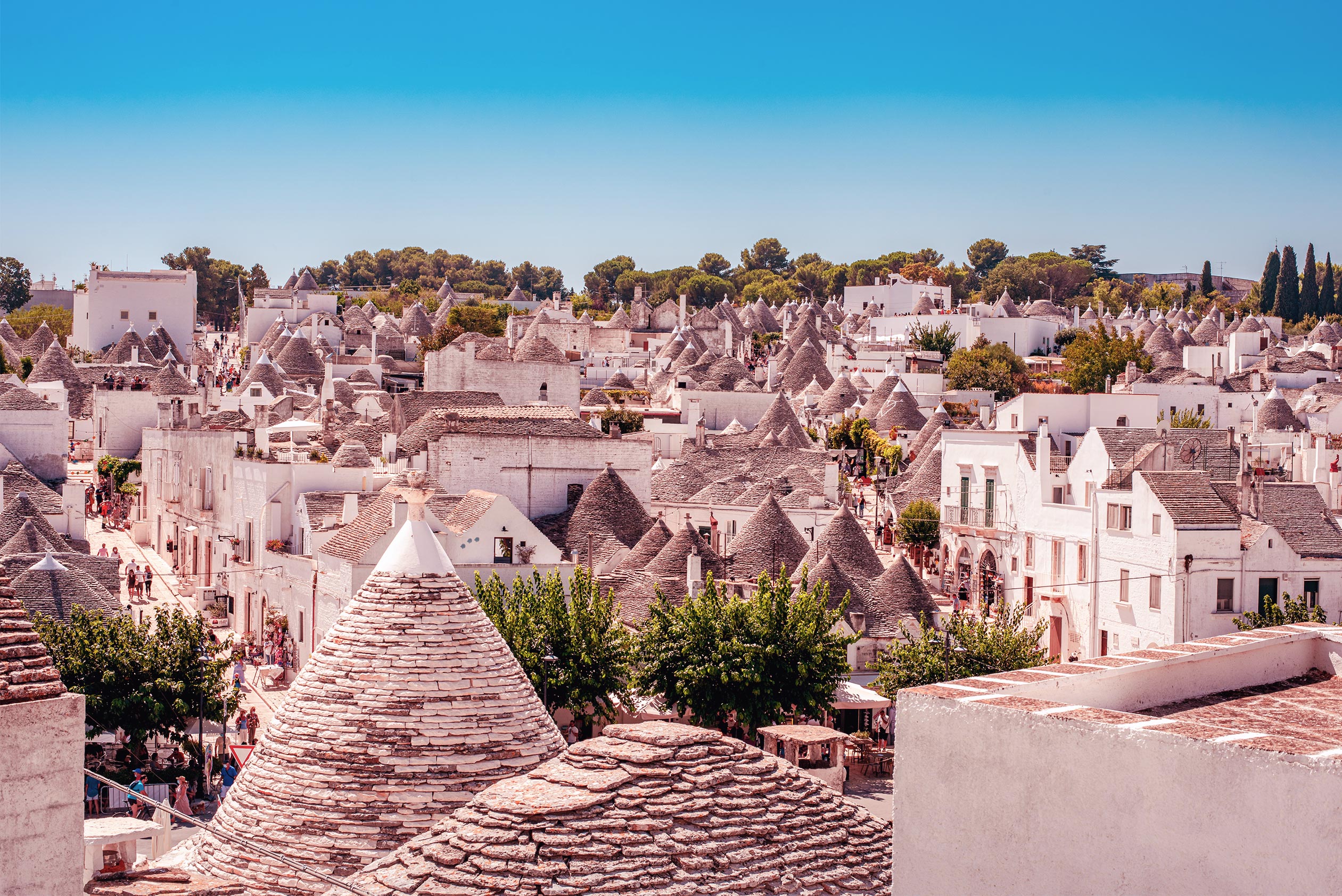10 interesting, fun and quirky facts about Puglia

Puglia is a region of historical and natural wonders, where spellbinding beaches mark the threshold between the Mediterranean and golden fields dotted by olive trees; where religious traditions shift from town to town, and where everything is imbued with history.
Such a place, as you can imagine, it cannot but have a few colorful stories under its belt. In this article, we share a few from the ones rooted in truth to the more whimsical ones.
Miracles in Lecce
In Piazza Sant’Oronzo, the eighteenth-century statue of the Patron Saint sits on a bare column, originally from the town of Brindisi. This column marked the end of the Via Appia, one of the most important roads in Ancient Rome. It was donated by the people of Brindisi to the Patron Saint of Lecce, when the town was miraculously spared by the plague that ravaged Salento in the seventeenth century.
Swindlers in Alberobello
Famous for its trulli, one of the house styles you can only find in Puglia, this town was gifted to the first Count of Conversano by Robert of Anjou, as a reward for taking part in the Crusades. The oldest trulli date back to the fourteenth century and they were built without mortar so that they could be easily dismantled in case the emissaries of the Kingdom of Naples, which imposed heavy taxes on any new house, came by to check on the inhabitants.
Gods and dolphins in Taranto
The legends surrounding the foundation of this town are colorful and endlessly fascinating. They often feature Taras (you can see where the name of the town comes from) and dolphins, both now part of the town’s heraldry. We’re not used to thinking of dolphins as something if you find in Europe, but the Gulf of Taranto has been home to dolphins for over 4,000 years and even today it is not uncommon to see them not too far from the town.
According to Greek mythology, Taras was the son of the nymph Satyria and Neptune, the god of the sea. He was the head of a fleet that arrived on the banks of the river where the town was later built. He immediately started offering sacrifices to thank his father for the good voyage they had and to enquire whether it was wise to build a town here when suddenly he saw a dolphin jump into the waters of the river. The young man interpreted this apparition as a sign of Neptune’s encouragement to found Taranto.
Along the Templar trail in Puglia
The history of the Knights Templar is certainly one of the most famous and fascinating in Christian history. Many people are familiar with it but few know that the Knights of Christ and the Temple of Solomon were also present in Puglia. The first official document attesting to the presence of the Templars in the region dates back to 1143. It is a chronicle of Armando, deacon of Trani, who recounts the participation of the knights in a religious ceremony.
Today there are still many traces of the knights in Puglia, some are clearly visible, others hidden. In Lecce, at the Church of Santa Maria del Tempio and at the Archaeological Museum Faggiano, one can find many symbols related to the Templars, like the “Flower of Life”. On a plaque, there is a text in Latin that reads “If God is with us, who is against us?”, which then became one of the mottos of the templars. These aren’t the only examples, there are many churches in Puglia that feature patent crosses, Baphomet crosses and other ancient engravings related to the order.

Lovers and thieves in Bari
In Piazza Mercantile, you can see the Column of Justice (also known as Column of Shame and in Italian Colonna Infame), where insolvent debtors were tied and left at the mercy of the public. But there’s more. If Verona has Juliet’s balcony, Bari has the Arch of Marvels. Legend has it that this arch was built to allow the passage of two lovers whose houses were on opposite sides of the street. One of these houses belonged to an ancient family called Meravigli but the ‘wonder’ relates not to the name of the family itself (‘meravigli’ means wonder in Italian) but to the fact that the arch was built in one night only! Love makes us do impossible things!
Recharging the batteries in Otranto
In Minervino di Lecce, just a few kilometers from Otranto, there is one of the most mysterious and magical places in Italy, the Dolmen li Scusi.
If you happen to come here during the Summer Solstice, you’ll be able to see the beautiful spectacle of the sun’s rays inside the dolmen, through the hole placed on the horizontal monolith. That’s not all that makes this site special. Apparently, here there is a strong electromagnetic field that makes people feel better. The presence of such conditions has been proven scientifically, the effects it has one people haven’t, but it can’t hurt to try!
Arithmetic mysteries in Castel del Monte
Perhaps the most enigmatic of them all, this octagonal castle is steeped in mystery. Scholars can’t explain why this particular location was chosen after all the hill has no strategic advantage. However, legend has it that here stood an ancient temple with an inscription “Now my head is bronze but in May it will be golden”. Nobody could solve the riddle but a Saracen, who, on the first day of May decided to start digging as soon as the sun began to rise, at the exact point where the shadow of the statue was cast. And right there, he found a treasure that, according to the story, was used for building Castel del Monte, now a UNESCO World Heritage Site. The octagonal plan of the castle, with 8 octagonal towers, always has the same shape, no matter where you look at it. The number 8 recurs everywhere in this building. It represents perfection because, especially when it is represented upside down (horizontally), it symbolizes the union of God with the man. There are elements that, if multiplied, result in Frederick II’s age, 56 (he resided here). The other connection to the emperor is the portal, that if vertically divided into two, shows a large “F”, initial of Frederick II of Swabia.
Upside down in Orimini
On the road SS172, descending from Taranto towards Martina Franca, if you stop the car without engaging any gear, it starts to move upwards and not downwards as it should on a road uphill. Legends on why it happens abound, especially since someone died in a car accident in this exact spot. It’s actually just a simple optical illusion: at the beginning, the road is downhill (ever so slightly it’s almost imperceptible) and only afterward it becomes uphill.
Gunshots and Madonnas in Martina Franca
Legend has it that during a siege in 1529, an invader and skilled sniper had found shelter in the church. He hid in the turret, behind the statue of the Madonna and shot the unaware inhabitants through a hole he had drilled. After a while, the inhabitants of Martina Franca, who were trying to resist the assault, clued up and came up with a plan. They found another skilled sniper who killed the other with a bullet which went through the hole. Today, when you enter the sacristy, where the statue is currently kept, you can put your finger in the dent the shot left in the cloak of the statue of the Madonna, evidence that the siege didn’t even spare the saints!
Decoding the church graffiti in Puglia
From a play of alquerque to Solomon’s knot, foot imprints and more, churches across Puglia bear ancient inscriptions. Most are undoubtedly memorial in nature, appearing with names, initials and dates inscribed within them. Some may be commemorating a visit to a site when on a pilgrimage.
Intrigued? Book a trip to Puglia with us to discover even more about this fantastic destination.
